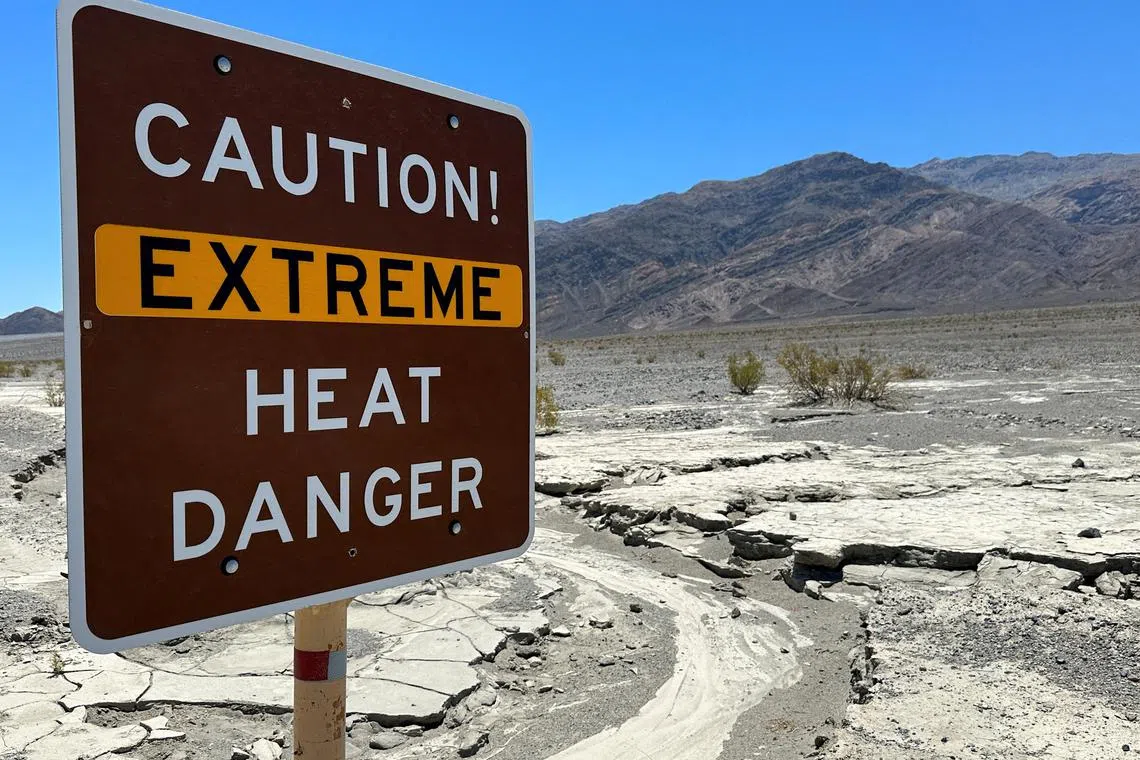Earth was due for another year of record warmth, but this warm?
Sign up now: Get ST's newsletters delivered to your inbox

A warning of extreme heat in Death Valley, California, on July 15, 2023. The US national park is the hottest place on Earth.
PHOTO: REUTERS
Follow topic:
NEW YORK – Earth finished up its warmest year in the past 174 years, and very likely the past 125,000.
Unyielding heat waves broiled Phoenix and Argentina. Wildfires raged across Canada. Flooding in Libya killed thousands. Wintertime ice cover in the dark seas around Antarctica was at unprecedented lows.
The year 2023’s global temperatures did not just beat prior records. They left them in the dust. From June through November, the mercury spent month after month soaring off the charts. December’s temperatures largely remained above normal, with much of the north-eastern United States experiencing springlike conditions last week.
That is why scientists are already sifting through evidence – from oceans, volcanic eruptions, even pollution from cargo ships – to see whether 2023 might reveal something new about the climate and what we are doing to it.
One hypothesis, perhaps the most troubling, is that the planet’s warming is accelerating, that the effects of climate change are barrelling our way more quickly than before.
“What we are looking for, really, is a bunch of corroborating evidence that all points in the same direction,” said climate scientist Chris Smith of the University of Leeds. “Then, we are looking for causality. And that will be really interesting.”
As extreme as 2023’s temperatures were, they did not catch researchers off guard. Scientists’ computational models offered a range of projected temperatures, and 2023’s heat was still broadly within this range, albeit on the high end.
On its own, one exceptional year would not be enough to suggest something was faulty with the computer models, said Professor Andrew Dessler, an atmospheric scientist at Texas A&M University.
Global temperatures have long bobbed up and down around a steady warming trend because of cyclical factors such as El Nino, the climate pattern that appeared in spring and had intensified since, possibly signalling more record heat to come in 2024.
“Your default position has to be, ‘The models are right’,” Prof Dessler said. “I am not willing to say that we have ‘broken the climate’ or there is anything weird going on until more evidence comes in.”
One thing researchers will be watching is whether something unexpected might be happening in the interplay of two major climate influences: The warming effect of greenhouse gases such as carbon dioxide and the cooling effect of other types of industrial pollution.
For much of the past 174 years, humans have been filling the skies with both greenhouse gases and aerosols, or tiny particles from smokestacks, tailpipes and other sources. These particles are harmful to the lungs when inhaled. But in the atmosphere, they reflect solar radiation, partly offsetting the heat-trapping effect of carbon dioxide.
In recent decades, however, governments have begun reducing aerosol pollution for public health reasons. This has already caused temperature increases to speed up since 2000, said scientists.
And in a much-discussed report in November, climate researcher James Hansen argued that scientists had vastly underestimated how much more the planet would warm in the coming decades if nations cleaned up aerosols without cutting carbon emissions.
Not all scientists are persuaded.
Arguments like Dr Hansen’s have been hard to square with patterns in recent decades, said Professor Reto Knutti, a climate physicist at Swiss university ETH Zurich.
In recent years, scientists have also discovered that global warming is shaped not just by how much heat is trapped near Earth’s surface, but also by how and where this heat is distributed across the planet.
This makes it even harder to conclude with confidence that warming is poised to accelerate, Prof Knutti said. Until the current El Nino is over, “it is unlikely we will be able to make definitive claims”, he said.
Pinning down the precise scale of aerosols’ effect has been difficult, too.
Part of how aerosols cool the planet is by making clouds brighter and deflecting more solar radiation. But clouds are devilishly complex, coming and going, and leaving few traces for scientists to examine, said Dr Tianle Yuan, a geophysicist with Nasa and the University of Maryland, Baltimore County. “That is fundamentally why it is a hard problem,” he said.
Aerosols have been of particular interest because of a 2020 international regulation that restricted pollution from ships. Dr Yuan and others are trying to identify how much the regulation might have increased global temperatures in recent years by limiting sunlight-reflecting aerosols.
Dr Hansen’s argument for faster warming leans in part on reconstructions of climatic shifts between ice ages over the past 160,000 years.
Using Earth’s distant past to make inferences about climate in the coming years and decades can be tricky. Still, the planet’s deep history highlights how extraordinary the present era is, said Professor Barbel Honisch, a scientist at Columbia University’s Lamont-Doherty Earth Observatory.
Fifty-six million years ago, for instance, geologic turmoil added carbon dioxide to the atmosphere in quantities comparable to what humans are adding today.
Temperatures jumped. The oceans grew acidic. Species died en masse.
“The difference is that it took about 3,000 to 5,000 years to get there” back then, Prof Honisch said, compared with a few centuries today.
It then took Earth even longer to neutralise that excess carbon dioxide: About 150,000 years. NYTIMES

